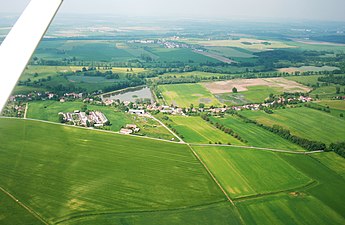Josefov Meadows
Restoration of the wet meadows
The Czech Society for Ornithology started buying up land in an area next to the river Metuje and restoring and imitating its original appearance and function of a floodplain. Thanks to public donations and sponsors, the Society has bought and repaired a hundred-year-old irrigation system that maintains a higher level of groundwater and is used twice-yearly to imitate natural spring and autumn flooding of the meadows. The area is managed with the view to accommodate not only wild animals but also the visitors who come to see them, therefore there are also maintained paths, a bird feeder, observatory towers. The Society is building ponds and clearing out aggressively growing plants, cutting the grasses only after the nesting birds had time to hatch.
The area is changing every year towards the desired goal with many species returning to it including rare and endemic ones.
Fauna
The 2017 census counts high numbers of 25 species of dragonflies including endangered and rare ones, 217 species of beetles, hundreds of amphibians, and rising variety of birds.
Over ten-year period of the reserve's existence there have been observed 166 bird species. More than ten of them even nesting there including northern lapwing, common snipe, water rail, spotted crake and little crake. In 2016 there have been observed for example short-eared owl, common crane, northern shoveler or garganey, attempting to nest thanks to the appearance of Eurasian beaver.
Among the returned amphibians are frogs and newts, newly appeared are European green toad and European fire-bellied toad.
The 25 species of the odonata genus illustrates the improving quality of the protected ecosystem, with southern emerald damselfly and yellow-winged darter dependent on the wet meadow environment, rare in the Czech Republic.
There is probably twice the counted number of beetle species including great silver water beetle, 5 listed as endangered and 6 specially protected.
Conservation grazing
In January 2018, five young Exmoor stallions arrived on loan by Česká krajina o.p.s. from Milovice Nature Reserve to help maintain the biodiversity of part of the wet meadows by grazing, creating varied environment of diverse vegetation cover which is ideal for birds - hiding in taller grasses, collecting food in areas grazed low. Since the wild horses are not being chemically dewormed, their manure is attractive to many insect species, providing additional source of food to local birds.
Gallery
-
Josefov Fortress on the left, the park is to the right, photo from air.
-
Aerial photo of the park, up and to the left of the lake.
-
Aerial photo of Jaroměř airport, the park is the uppermost green strip seen above it.
-
Part of Josefow Meadows viewed from air - the triangle of land between Stará Metuje and Metuje rivers.
See also
References
- ^ "ČSO - Česká společnost ornitologická". Cso.cz. Retrieved 3 August 2018.
- ^ "Ptačí park Josefovské louky". Darujme.cz. Retrieved 3 August 2018.
- ^ "Z obyčejné louky ornitologové vytvořili ráj nejen pro ptáky - Česká společnost ornitologická". Birdlife.cz. 3 January 2018. Retrieved 3 August 2018.
- ^ "Tabulka pozorovaných druhů v Ptačím parku Josefovské louky s uvedením maximálního počtu jedinců pozorovaných v jednom dni (k 25. 9. 2017)" (PDF). Bigfiles.birdlife.cz. Retrieved 3 August 2018.
- ^ "Výroční zpráva České společnosti ornitologické" (PDF). Bigfiles.birdlife.cz. 2016. Retrieved 3 August 2018.
- ^ "Josefovské louky letos oslavily desáté narozeniny - Česká společnost ornitologická". Birdlife.cz. 24 September 2017. Retrieved 3 August 2018.
- ^ "Divocí koně z Milovic se už zabydlují ve dvou lokalitách na východě Čech". Ceska-krajina.cz. Retrieved 23 February 2018.
External links
- https://www.cso.cz/index.php?a=cat.1005 - Czech Society for Ornithology archive website
- http://www.birdlife.cz - Czech Society for Ornithology new official website



